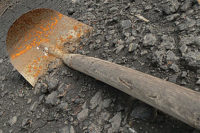You can save big bucks on those large heated slab jobs.
In my opinion, big garages are one of the best applications for radiant floor heating. Included in this category are fire stations, aircraft hangers, highway garages, bus garages or other large vehicle-service facilities.
These buildings usually have several large doors that open, sometimes quite frequently, during inclement weather. The inrush of cold air across the floor is quickly countered by the “thermodynamic determination” of several hundred tons of warm concrete. That thermal mass instantly springs into action, temporarily releasing heat at several times its normal rate. This allows regular comfort to be restored almost immediately after those doors get closed.
Other benefits of floor heating in such facilities include:
- A system that is almost entirely away from sometimes rough interior activities.
- A system that can quickly dry up wet floors caused by vehicles coming in with several hundred pounds of snow and ice attached.
- The ability to use a variety of heat sources, including waste oil boilers that help dispose of oil drained from a fleet of trucks, buses, etc.
- Relatively low per sq.-ft. installation cost because the slab is already there.
Large buildings also bring some baggage to radiant heating systems. In many situations, there is a need to send heat to manifold stations that may be a long way from the mechanical room (think several hundred ft. in one direction).
Some designers would just pipe the supply water, at the temperature required by the floor circuits, all the way from the mechanical room to the remote manifold station(s). This is certainly possible but when those manifold stations get large, the required pipe sizes to the manifold station can quickly grow to 1.5 in. or even 2 in. Think about how much it costs to install perhaps 500 ft. of 2-in. copper tubing - much of it on overhead hangers - just to convey heat to a single remote manifold station that may in turn have to deliver 250,000 Btu/hr. to its floor circuits under design load. That cost might even rival the cost of the PEX tubing served by that manifold station.
Leveraging wide ∆T
This is where a minitube distribution system might save several thousand dollars. Minitube distribution systems are a specialized application of injection mixing. They are well-suited to projects where a conventional boiler that operates with water temperatures in the range of 160° F to 180° F under design load conditions supplies a low temperature load such as slab-type floor heating.
Like most injection mixing applications, minitube distribution systems leverage the high temperature difference between a “hot” boiler and a low temperature heating distribution system. This high temperature difference allows a relatively low flow rate to carry a significant amount of heat. Reduced flow rates allow for smaller piping and smaller circulators.
Most injection mixing systems used with radiant floor heating perform the mixing in the mechanical room and distribute relative low temperature water to manifold stations. The piping details for a typical injection mixing system are shown in Figure 1. Using this approach, the piping between the mechanical room and manifold station(s) must be sized for the flow rate associated with a typical manifold temperature drop of 15° F to 20° F.
In minitube systems, the mixing takes place at the manifold station(s). The piping between the mechanical room and manifold station is now sized for the flow rates associated with a much higher temperature difference (e.g. the boiler outlet temperature minus the floor circuit return temperature). In many cases, this temperature difference is four or more times greater than the temperature drop across the manifold station.
Flow figures
The required injection flow rate for any injection mixing system is inversely proportional to the temperature difference between the hot water being injected and the cooler water returning from the manifold station. The greater this temperature difference is, the lower the required injection flow rate. This relationship is given by Formula 1.
Where:
fi = Required injection flow rate at design load (gpm).
Q = Rate of heat transfer to distribution system at design load (Btu/hr.).
∆T = Temperature difference between supply and return injection risers (°F).
k = A constant depending on fluid used (For water, k=490; For 30% glycol solution, k=479; For 50% glycol solution, k=450).
For example, assume a large manifold station is supplying 250,000 Btu/hr. to a heated floor slab in a large garage under design load conditions. The supply water temperature to the floor circuits under those conditions is 110° F and the water returns from the circuits at 90° F. Hot water from a cast-iron boiler is available at 180° F. Determine the required injection flow rate (See Formula 2).
This relatively low flow rate can easily be handled by 3/4-in. PEX, PEX-AL-PEX, PP-R, or copper tubing.
Going the distance
The minitube approach takes advantage of these small piping sizes and “stretches them out” from the mechanical room to the manifold station as shown in Figure 2.
To see why this is an advantage, consider a situation in which the manifold station supplying 250,000 Btu/hr. at design load is located 200 ft. away from the mechanical room in a large highway garage. Also assume the piping between the mechanical room and manifold station is routed vertically upward to a 25-ft.-high ceiling and then back down to the manifold station. In total there is 500 ft. of supply plus return piping required between the mechanical room and this manifold station.
If the mixing were done in the mechanical room, the required flow rate to and from this manifold station would be (See Formula 3):
This flow rate would require 2-in.-size tubing such that a reasonable flow velocity and pressure drop exists.
Now, estimate your cost to install 500 ft. of 2-in. copper tubing with 80% of it supported from the ceiling. A conservative estimate of $25 per ft. installed puts the total cost of this piping at $12,500.
When the minitube approach is used, the 500 ft. of 2-in. copper tubing could be replaced with 500 ft. of 3/4-inch PEX-AL-PEX. If the installed cost of the latter was estimated at $5 per ft., the installed cost savings for this single manifold station would be $10,000! That’s a huge savings. Think of it as a benefit of having the laws of thermodynamics on your side.
Figure 3 shows the modern way to set up a multi-zone minitube system.
This system uses a hydraulic separator between the boilers and injection pumps. This device provides three desirable functions:
- Hydraulic separation between the injection pumps and boiler circulators.
- Central air separation.
-
Central dirt separation.
Arguably, these functions could be provided using other multiple hardware components, but not with the installation simplicity and minimal space requirement offered by the “3-in-1” functionality of the hydraulic separator. It is important to generously size the headers on both sides of the hydraulic separator. My suggestion is to select a piping size that keeps the maximum flow velocity at around 2 ft. per second. This will result in very little pressure drop along the length of the headers. Low pressure drop in the headers and hydraulic separator creates very little tendency for the circulators to interact with each other.
Several hardware options also are available to control the multiple injection pumps involved in a multi-zone minitube system. Examples include variable-speed injection pump controllers from tekmar, Taco, Honeywell and HBX.
There also are some circulators currently on the market from Taco and Grundfos that have a complete injection mixing controller built in. While these are still standalone vs. networked devices, they eliminate the need of separate controls, and speed installation. In the future, keep your eyes open for ECM-based circulators that also have the necessary logic for outdoor reset-based injection mixing controls already built in.
Other hardware that could speed installation of a minitube system includes Webstone’s recently released Hydro-Core hydraulic separation interface/purging valve. This component would allow the injection pump to be located near the manifold station as shown in Figure 4. The injection pump will function equally well in this location.
There have been many successful applications of minitube distribution systems ranging from residential retrofits all the way up to 170,000-sq.-ft. industrial slab-on-grade buildings. The availability of new hardware further simplifies the installation. Keep this approach in mind the next time someone drops off a set of plans for one of those big garage jobs.















